Intel Xeon E-2146G Benchmarks
For this exercise, we are using our legacy Linux-Bench scripts which help us see cross-platform “least common denominator” results we have been using for years as well as several results from our updated Linux-Bench2 scripts. At this point, our benchmarking sessions take days to run and we are generating well over a thousand data points. We are also running workloads for software companies that want to see how their software works on the latest hardware. As a result, this is a small sample of the data we are collecting and can share publicly. Our position is always that we are happy to provide some free data but we also have services to let companies run their own workloads in our lab, such as with our DemoEval service. What we do provide is an extremely controlled environment where we know every step is exactly the same and each run is done in a real-world data center, not a test bench.
We are going to show off a few results, and highlight a number of interesting data points in this article.
Python Linux 4.4.2 Kernel Compile Benchmark
This is one of the most requested benchmarks for STH over the past few years. The task was simple, we have a standard configuration file, the Linux 4.4.2 kernel from kernel.org, and make the standard auto-generated configuration utilizing every thread in the system. We are expressing results in terms of compiles per hour to make the results easier to read:

One can see slight increments between the Intel Xeon E-2146G, and the SKUs immediately above and below. This is going to be a theme. Single threaded performance is similar between the two lower-end SKUs with 4.5GHz max turbo boost speeds. That tends to make the results SKU closer to the Intel Xeon E-2136.
c-ray 1.1 Performance
We have been using c-ray for our performance testing for years now. It is a ray tracing benchmark that is extremely popular to show differences in processors under multi-threaded workloads. We are going to use our 8K results which work well at this end of the performance spectrum.

AMD typically performs extremely well in this benchmark. One interesting point is that the Xeon E-2100 6-core SKUs with their higher clock speeds are able to keep up with, and often surpass 8-core low power SKUs.
7-zip Compression Performance
7-zip is a widely used compression/ decompression program that works cross-platform. We started using the program during our early days with Windows testing. It is now part of Linux-Bench.

Compression is important because so many applications use compression to save on space. Here, the 6-core Intel Xeon E-2146G performs extremely well, well above the Intel Xeon Silver 4108 and Silver 4110 8-core SKUs.
NAMD Performance
NAMD is a molecular modeling benchmark developed by the Theoretical and Computational Biophysics Group in the Beckman Institute for Advanced Science and Technology at the University of Illinois at Urbana-Champaign. More information on the benchmark can be found here. We are going to augment this with GROMACS in the next-generation Linux-Bench in the near future. With GROMACS we have been working hard to support Intel’s Skylake AVX-512 and AVX2 supporting AMD Zen architecture. Here are the comparison results for the legacy data set:
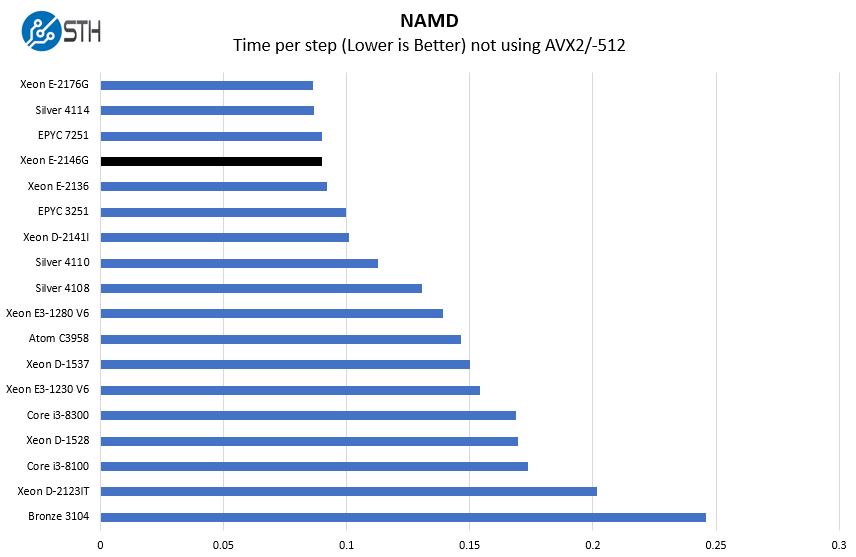
Here again, high clock speeds do well. At $311 and with low-cost motherboard platform options, this may be the best price/performance option on the list with one big caveat. The Intel Xeon E-2100 series currently supports 4x 16GB for 64GB of RAM. Later in its lifecycle, there will be 32GB ECC UDIMMs which will increase RAM capacity to 128GB. Still, the Intel Xeon E-2100 series does not have much by way of RAM capacity and PCIe lanes compared to others on that list. Even the Intel Atom C3000 series has more RAM capacity than the Intel Xeon E-2100 series, and it can use elss expensive RDIMMs.
Sysbench CPU test
Sysbench is another one of those widely used Linux benchmarks. We specifically are using the CPU test, not the OLTP test that we use for some storage testing.

Here the impressive part is that the Intel Xeon E-2136 is approaching 10 core Intel Xeon Silver 4114 speeds.
OpenSSL Performance
OpenSSL is widely used to secure communications between servers. This is an important protocol in many server stacks. We first look at our sign tests:
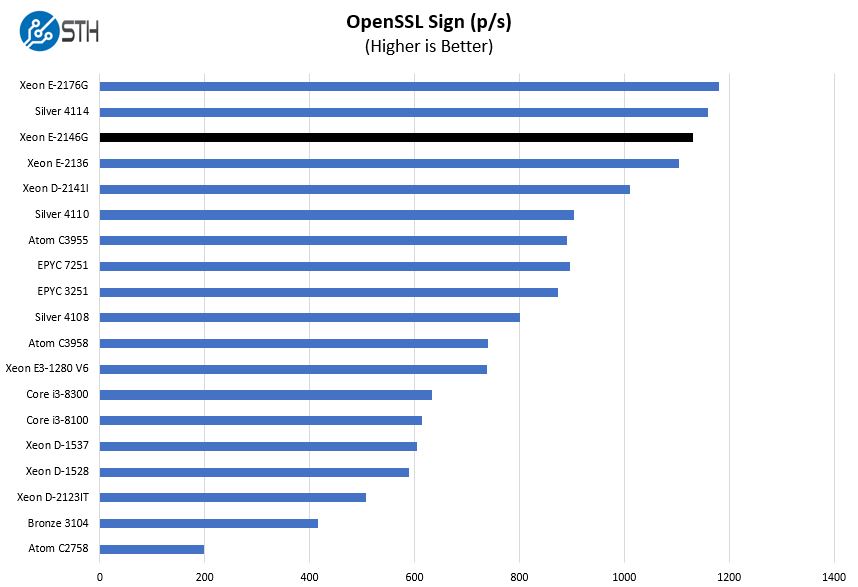
Here are the verify results:
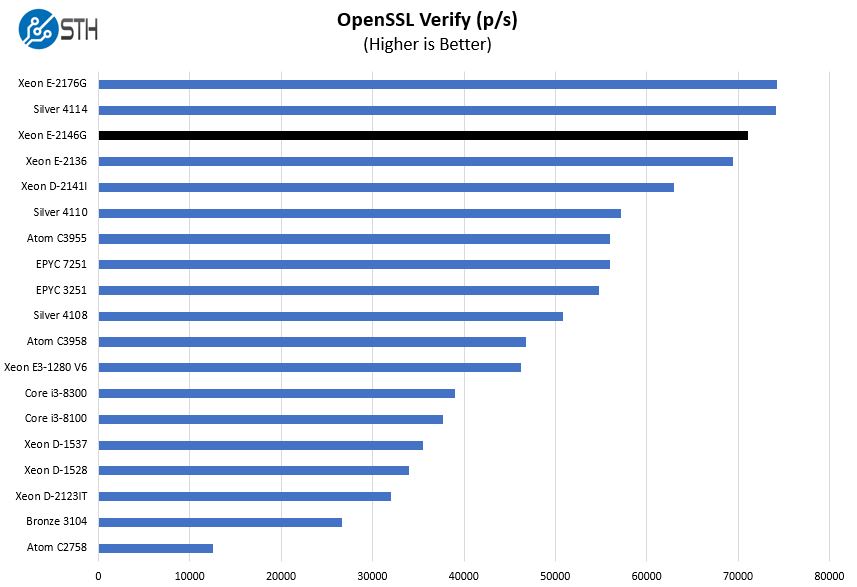
Again we see the Intel Xeon E-2146G in the middle of other 6-core Xeon E-2100 series CPUs. We also wanted to point out that it is faster here than the Intel Xeon D-2141I which is an 8-core CPU meant for the embedded market. If you consider that the E-2146G is socketed, and is over $200 less expensive with an onboard GPU, you quickly see the value in these parts if you do not need RAM and PCIe capacity.
UnixBench Dhrystone 2 and Whetstone Benchmarks
Some of the longest-running tests at STH are the venerable UnixBench 5.1.3 Dhrystone 2 and Whetstone results. They are certainly aging, however, we constantly get requests for them, and many angry notes when we leave them out. UnixBench is widely used so we are including it in this data set. Here are the Dhrystone 2 results:
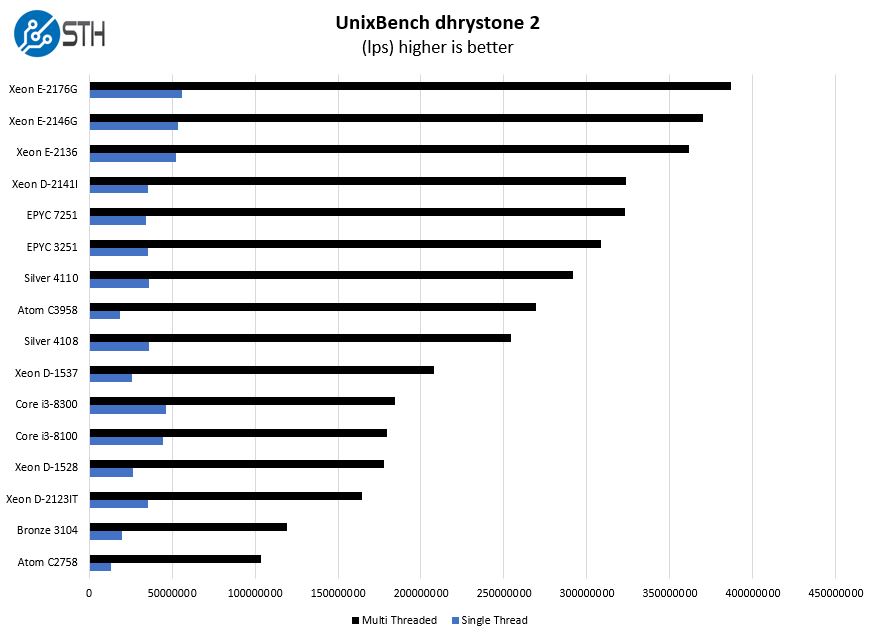
Here are the whetstone results:
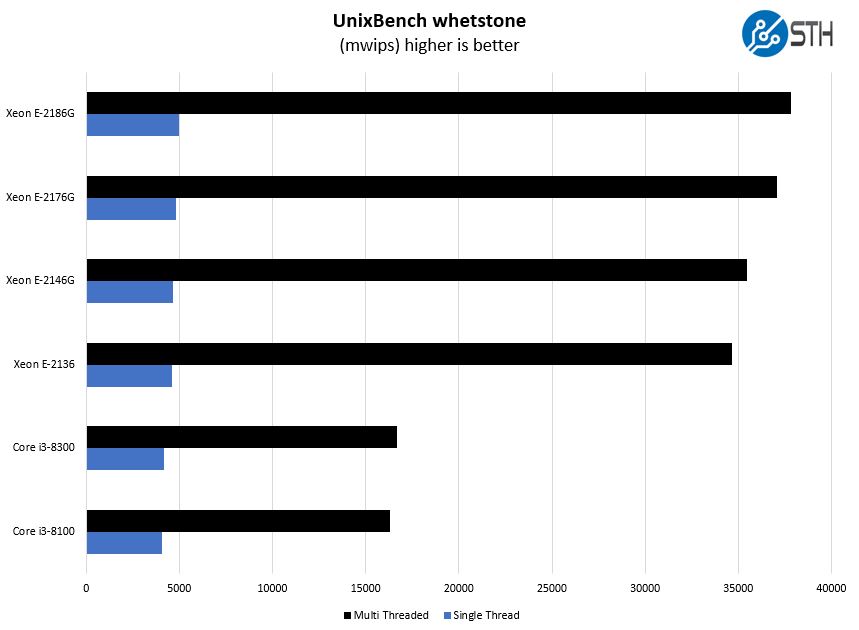
We again did the double-click into socket compatible SKUs for the whetstone results just to show how close the Xeon E-2100 series parts are, but also to show the gap between quad-core parts.
GROMACS STH Small AVX2/ AVX-512 Enabled
We have a small GROMACS molecule simulation we previewed in the first AMD EPYC 7601 Linux benchmarks piece. In Linux-Bench2 we are using a “small” test for single and dual socket capable machines. Our medium test is more appropriate for higher-end dual and quad socket machines. Our GROMACS test will use the AVX-512 and AVX2 extensions if available.

We wanted to draw attention to the 16-core Intel Xeon D-1587 here. Some of the embedded parts have impressive core counts, but thermal headroom limits performance running with all cores. The Intel Xeon D-1587 is a prime example of that aspect at work. Given the higher clock speeds, and the ability to run at Turbo frequencies on newer generations of cores, the Intel Xeon E-2146G is almost as fast as the 16 core part here.
Chess Benchmarking
Chess is an interesting use case since it has almost unlimited complexity. Over the years, we have received a number of requests to bring back chess benchmarking. We have been profiling systems and are ready to start sharing results:

In our last chart, we see a familiar pattern. The Intel Xeon E-2146G is between the Intel Xeon E-2176G and the Intel Xeon E-2136, slightly closer to the latter. While the AMD EPYC 7251 is a more expensive 8-core part, having a higher clock speed across six cores and a single NUMA domain means that the Intel Xeon E-2146G is able to easily notch a win. The flip side is, of course, that the AMD EPYC 7251 can handle significantly more RAM and has 128 PCIe Gen3 lanes from the CPU. From a scale-up system perspective, the Intel Xeon E-2146G is unable to compete. If you are looking for a small system with solid CPU/ iGPU performance, then the Intel Xeon E-2146G is a good choice.
Next, we are going to have the power consumption, market positioning, and our final words.

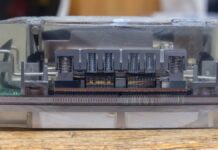


This has shades of Tom’s infamous RTX 2080 Ti just buy it now.
Sinclair this is really different right? Tom’s now recommends stuff because it’s new before they test it. The GTX 1080 Ti or RTX 2080 are better buys than the 2080 Ti but Tom’s said to go buy it without testing.
Here they’re giving an opinion, but they’ve got power and performance data for other chips in this family as well as other families from AMD and Intel.
People have been giving up on Tom’s credibility because they’re recommending without data or work. This is a recommendation where they’ve gotten a big test data set and used that to inform a recommendation.
I think there are reasons to go with the E-2176G and E-2186G but they’ve got a point showing why you’re paying more for a small increase in performance.
I would love to buy one of these, but can’t find them in stock anywhere. Same with boards in a mATX and mITX format.
Tomshardware said buy with no data. There is plenty here and reasoning to support it.
There is pretty much no use case where the Intel “Xeon” E-2000 series makes sense. If you do signage or edge transcoding (as I do in every day life) the X11SCA-F and other C246/C242 motherboard also support the i3 series CPUs which will offer all the same features or the i5 (and now also the i9 series) which trade ECC support for higher clocks. Given that transcoding use cases are not prone to memory errors or corruption this is an instant 50% cost saving on the CPU for equal performance.
If you care about ECC changes are you care about memory intensive applications, in which case Xeon D for Edge compute, Xeon W for workstation or Xeon Scalable make sense. Xeon E-2000 is an artifical product segment that has no right to exist, were it not that Ryzen motherboards with BMC are non-existent. I would not be surprised if at a later date it will come to light that Intel pressured partners into prioritizing C242/C246 lines by providing incentives.
David that’s silly. They’ve been selling these for years. There’s even a link in this article to the history of them. If you’re selling dedicated hosting servers, the E3 and now E-2100 are way cheaper than anything else.
Tony historically they had features that set them apart from the consumer chips (like ECC,HyperThreading or thermal tolerances) which is no longer the case.
Right now it’s difficult to argue to buy the same chip with a different name but at a 25-30% premium.
There is a definite market for this in the homelab market, although we all know how niche that is. Ideally we all want something that can support things like FreeNAS, Unraid, etc., but also utilize the iGPU to offload transcoding, and to typically do it in a small package. That doesn’t leave many options. This is one of them.
It seems that in the most of the EU the new E-2xxx series is unobtanium.